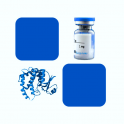
- Remove this product from my favorite's list.
- Add this product to my list of favorites.
Products
Viewed products
Newsletter
 |  |  |  |  |  |

Background
C-X-C chemokine receptor type 4 also known as fusin or CD184 (cluster of differentiation 184), CXCR4, CD184, D2S201E, FB22, HM89, HSY3RR, LAP3, LCR1, LESTR, NPY3R, NPYR, NPYRL, NPYY3R or WHIM. CXCR-4 is an alpha-chemokine receptor specific for stromal-derived-factor-1 (SDF-1 also called CXCL12), a molecule endowed with potent chemotactic activity for lymphocytes. This receptor is one of several chemokine receptors that HIV isolates can use to infect CD4+ T cells. HIV isolates that use CXCR4 are traditionally known as T-cell tropic isolates. Typically, these viruses are found late in infection. It is unclear as to whether the emergence of CXCR4 using HIV is a consequence or a cause of immunodeficiency.CXCR4 is upregulated during the implantation window in natural and hormone replacement therapy cycles in the endometrium, producing, in presence of a human blastocyst, a surface polarization of the CXCR4 receptors suggesting that this receptor is implicated in the adhesion phase of human implantation. SDF-1 and CXCR4 were believed to be a relatively "monogamous" ligand-receptor pair (other chemokines tend to use several different chemokine receptors in a fairly "promiscuous" manner). Recent evidence demonstrates ubiquitin is also a natural ligand of CXCR4. Chronic exposure to THC increased T lymphocyte CXCR4 expression on both CD4+ and CD8+ T lymphocytes. Drugs that block the CXCR4 receptor appear to be capable of "mobilizing" hematopoietic stem cells into the bloodstream as peripheral blood stem cells.
Source
Recombinant human CXCR4 Fc chimera (rhCXCR4-Fc), Fc Tag (CX4-H5269) is expressed from human 293 cells (HEK293). It contains AA Met 1 - Ser 46 (Accession # AAH20968.1).
Molecular Characterization
This protein carries a human IgG1 Fc tag at the N-terminus.
The protein has a calculated MW of 32.3 kDa. The protein migrates as 35-45 kDa under reducing (R) condition (SDS-PAGE) due to glycosylation.
Endotoxin
Less than 1.0 EU per μg by the LAL method.
Purity
>90% as determined by SDS-PAGE.
Formulation
Lyophilized from 0.22 μm filtered solution in 50 mM Tris, 100 mM Glycine, pH7.5. Normally trehalose is added as protectant before lyophilization.
Reconstitution
See Certificate of Analysis for details of reconstitution instruction and specific concentration.
Storage
For long term storage, the product should be stored at lyophilized state at -20°C or lower.
Please avoid repeated freeze-thaw cycles.
This product is stable after storage at:
-20°C to -70°C for 12 months in lyophilized state;
-70°C for 3 months under sterile conditions after reconstitution.
(1) "Ultrasonic microbubbles promote mesenchymal stem cell homing to the fibrotic liver via upregulation of CXCR4 expression"
Xu, Huang, Zhang et al
Cell Div (2024) 19 (1), 7
(2) "CD34+DNAM-1brightCXCR4+ haemopoietic precursors circulate after chemotherapy, seed lung tissue and generate functional innate-like T cells and NK cells"
Perrone, Bozzano, Dal Bello et al
Front Immunol (2024) 15, 1332781
(3) "[Research Progress on the Application Strategies of Plerixafor in the Peripheral Blood Stem Cell Mobilization for Autologous Transplantation--Review]"
Fang, Ye
Zhongguo Shi Yan Xue Ye Xue Za Zhi (2024) 32 (1), 322-326
Showing 1-3 of 16167 papers.
Follow us